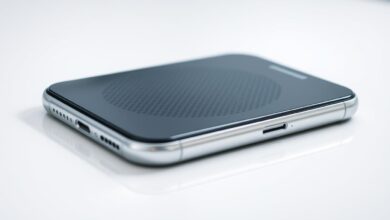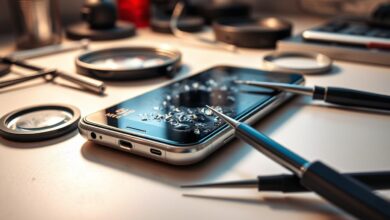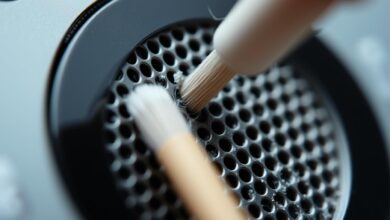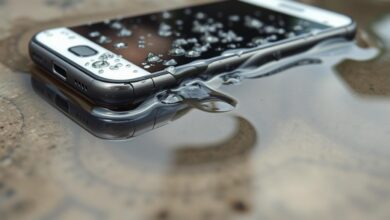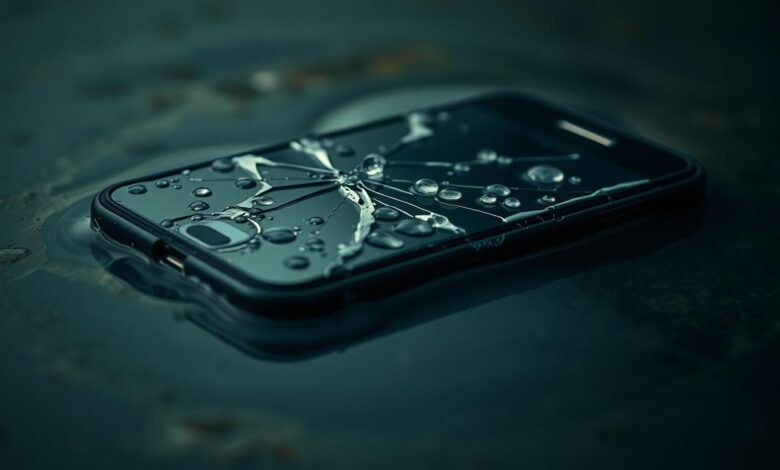
Accidental drops in the bathtub or unexpected downpours can be disastrous for your phone. Liquid damage can be a nightmare, but there are steps you can take to rescue your device.
I will walk you through the latest techniques and expert advice on water damage repair to help you restore your phone to its former glory.
Whether you’re dealing with a minor splashing incident or a full-blown submersion, this guide will provide you with the necessary steps to get water out and potentially save your device from permanent damage.
Key Takeaways
- Immediate actions to take when your phone gets wet
- Effective methods for water damage repair
- Tips to prevent further damage to your device
- Expert advice on assessing and addressing phone water damage
- Precautions to take when drying out your phone
Understanding Phone Water Damage
Water and electronics don’t mix well. Knowing how water affects your phone is key to preventing damage. When water gets into your phone, it can harm the inside parts a lot.
How Water Affects Your Phone’s Components
Water can get into your phone’s inner parts. This causes corrosion and short circuits. These issues can make your phone’s parts not work right or even stop working.
The damage’s extent depends on how much water your phone got and what kind of water it was.
Common Misconceptions About Water Damage
Many think water damage shows up right away. But, it can take a while to see the damage.
Some also think drying your phone fixes it. But, fixing water damage often needs water damage restoration or cleanup by experts.
Types of Water Damage: Fresh vs. Salt Water
The kind of water your phone gets wet in matters a lot. Salt water is more damaging than fresh water because it has more salt.
Knowing if your phone got wet with fresh or salt water helps you figure out what to do next. It guides you in choosing the right water damage cleanup steps.
Act Fast: Immediate Steps When Your Phone Gets Wet
When your phone gets wet, every second matters. Quick action can greatly improve your phone’s chances of recovery. The first minutes are key to see if your phone will make it.
Power Off Immediately
The first thing to do is to power off your phone right away. This is vital because if it’s on, electrical parts can short circuit. Turning it off stops any short circuits that could ruin your phone.
Remove Case, SIM Card, and Battery (If Possible)
Then, take off any extras like the phone case, SIM card, and battery if you can. This step helps to lower the chance of water getting into the inside parts. For phones with removable batteries, taking out the battery stops power surges that could harm the circuitry.
What NOT To Do When Your Phone Gets Wet
It’s also key to know what not to do. Avoiding common errors can boost your phone’s recovery chances.
Avoid Heat Sources
Don’t put your phone near heat like a hair dryer or oven to dry it. Heat can damage the inside parts.
Don’t Shake or Blow Into Ports
Another mistake is shaking your phone or blowing into its ports. This can push water deeper into the phone, causing more harm. Instead, gently pat the outside dry with a soft cloth.
| Immediate Action | Why It’s Important |
|---|---|
| Power off the phone | Prevents short circuits and further damage |
| Remove accessories and battery (if possible) | Reduces risk of water entering internal components |
| Avoid heat sources | Prevents damage to internal components from heat |
| Avoid shaking or blowing into ports | Prevents pushing water further into the phone |
By taking these quick steps, you can greatly increase your phone’s chances of recovery. Quick action and avoiding common mistakes are crucial for fixing a water-damaged phone.
The Rice Method: Does It Really Work?
Many people try the rice method to fix water-damaged phones. But does it really work? The idea is that rice can soak up moisture from the phone. This might save it from water damage. Yet, many question its effectiveness.
Science Behind the Rice Method
The rice method uses rice’s ability to absorb moisture. Rice is thought to be a desiccant, like silica gel. Putting your phone in rice is supposed to dry it out.
Desiccant Properties: Rice has starch that can absorb moisture. But, it’s not as good as other desiccants like silica gel.
Proper Technique for Using Rice
To use rice effectively, follow these steps:
- Power off your phone immediately.
- Remove any accessories or cases.
- Bury your phone in a container filled with uncooked rice, ensuring it’s fully covered.
- Leave it for at least 48 hours before checking.
Limitations and Potential Risks
The rice method might help in some cases. But, it has its limits and risks. For example, rice dust can damage your phone.
Rice Dust Concerns
Rice dust can be a problem. It may:
| Issue | Description | Potential Impact |
|---|---|---|
| Rice Dust Infiltration | Rice particles can enter the phone’s openings. | May cause damage to internal components. |
| Moisture Retention | Rice can sometimes retain moisture. | Could prolong the drying process or cause corrosion. |
| Static Electricity | Rice can generate static electricity. | Might damage sensitive electronic components. |
In conclusion, the rice method might help with water-damaged phones. But, it’s not always effective. Knowing its limits and risks is important before trying it.
Best Methods to Get Water Out of Phone
Removing water from your phone is crucial to avoid damage. When your phone gets wet, acting fast is key to reduce harm.
Using Silica Gel Packets
Silica gel packets are great for drying wet phones. You can find them in shoe boxes and electronic packaging. Place your phone in a container with several packets and seal it. The silica gel will soak up the moisture from your phone.
Benefits of Silica Gel Packets:
- Effective moisture absorption
- Easily available
- Low cost
Commercial Desiccants and Moisture Absorbers
Commercial desiccants and moisture absorbers are made for drying wet electronics. They work better than silica gel packets and are available online or in electronics stores. Always follow the manufacturer’s instructions for the best results.
Vacuum Method for Water Extraction
The vacuum method uses a vacuum to remove water from your phone. But, be careful not to damage your phone’s internal parts with too much suction.
Safe Vacuum Settings
To vacuum safely, use a low suction setting. You can also use a vacuum made for electronics or a vacuum chamber. Don’t push the vacuum nozzle too close to your phone’s openings to avoid damage.
| Method | Effectiveness | Cost |
|---|---|---|
| Silica Gel Packets | High | Low |
| Commercial Desiccants | Very High | Moderate |
| Vacuum Method | Moderate | Variable |
In conclusion, there are several ways to remove water from your phone. You can use silica gel packets, commercial desiccants, or the vacuum method. By picking the right method and following the right steps, you can save your device.
Using Isopropyl Alcohol for Water Displacement
Displacing water from your phone’s internal parts is key. Isopropyl alcohol helps in this process. Water damage can be costly or make your phone unusable. Isopropyl alcohol’s dehydrating properties can displace water and help dry your phone.
Why Alcohol Works for Water Damage
Isopropyl alcohol is great for water damage because it has lower surface tension. This lets it get into small spaces and push out water. It also evaporates fast, speeding up drying. This makes it perfect for fixing water-damaged phones.
Step-by-Step Alcohol Cleaning Process
To use isopropyl alcohol for water displacement, follow these steps:
- Power off your phone immediately to prevent any short circuits.
- Remove any external accessories, such as cases or SIM cards.
- Dampen a soft cloth with isopropyl alcohol (ensure it’s not soaking wet).
- Gently wipe down the exterior and any accessible internal components.
- Use a desiccant or let the device air dry.
Safety Precautions When Using Alcohol
While isopropyl alcohol is effective, use it carefully. Don’t let alcohol get into openings or ports, as it can harm certain parts. Use high-concentration isopropyl alcohol (at least 90%) to avoid residue. Always work in a well-ventilated area to avoid inhaling fumes.
Knowing how to use isopropyl alcohol for water displacement is crucial. This method, along with other drying techniques, can greatly improve your phone’s chances of being fixed. By following these steps, you can take a big step in phone water repair.
Drying Techniques for Different Phone Models
Knowing how to dry your phone depends on its model. Each phone is different, needing its own drying method. This ensures water damage is fixed properly.
iPhone-Specific Drying Methods
iPhone users must act fast. Use silica gel packets or uncooked rice to soak up moisture. But, be careful not to get rice into the phone’s openings. Newer iPhones with IP67 or IP68 ratings might need a different approach because of their water resistance.
Android Phone Drying Techniques
Android phones need different drying methods based on their maker and model. Some can have their batteries removed to dry separately. A desiccant or commercial drying product for electronics works well. Check if the maker has special drying instructions for your model.
Special Considerations for Water-Resistant Phones
Phones with IP67 or IP68 ratings can handle some water. But, they’re not fully waterproof. Knowing the difference between these ratings is key.
IP67 vs. IP68 Ratings
IP67 phones can handle water up to 1 meter for 30 minutes. IP68 phones can go deeper, with specific conditions set by the maker. Still, water damage can happen, so drying methods must be used carefully.
For more detailed drying methods, check out additional resources. They offer detailed guides on fixing wet iPhones and Androids.
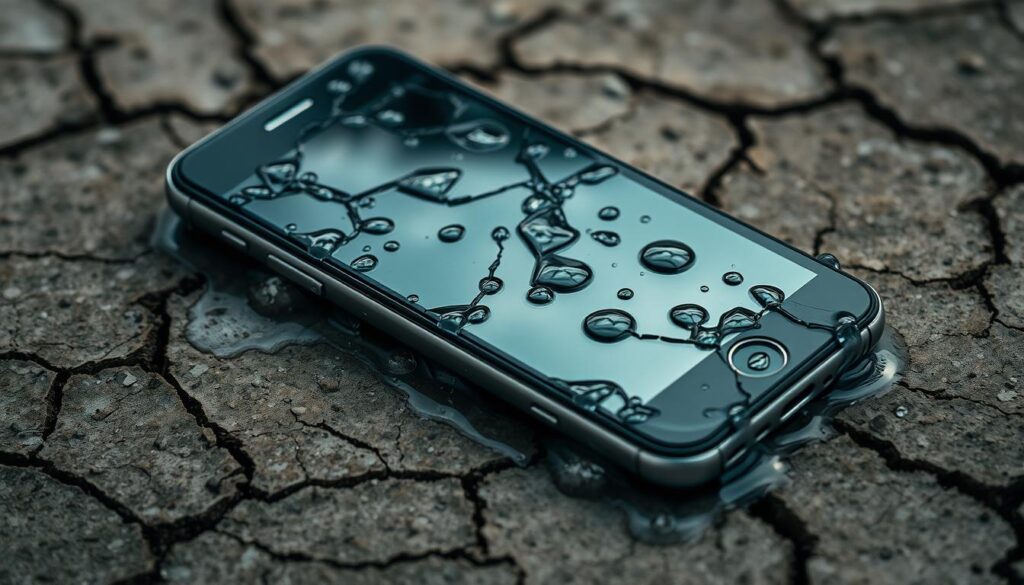
Using Compressed Air to Remove Water
Compressed air can help remove water from your phone, but use it carefully. It can be effective in some areas but might damage others if not used right.
Proper Technique for Using Compressed Air
To use compressed air well, hold the can upright. Spray short bursts from about 6 inches away. Aim at places like the charging port and speaker grills. This method can help get water out without pushing it deeper into your phone.
Potential Risks and Precautions
Compressed air can push water deeper into your phone if not used right. Don’t spray too close or in a steady stream. Also, avoid tilting the can to prevent liquid propellant from damaging your phone’s inside.
When to Avoid Compressed Air
Don’t use compressed air in some cases. If your phone was underwater for a long time or has water on the screen, don’t use it. Instead, get professional help for water damage cleanup.
| Method | Effectiveness | Precautions |
|---|---|---|
| Compressed Air | Effective for removing water from ports and grills | Use in short bursts, avoid tilting can |
| Silica Gel | Good for drying out moisture over time | Avoid ingesting, keep away from children |
| Professional Repair | Best for severe water damage | Costly, but often the most effective solution |
Knowing how to use compressed air and its limits can help in your phone water repair efforts. It’s a good way to get water out of your phone.
Professional Water Damage Restoration Tools
Professional tools are key in fixing water-damaged phones. Fixing a phone after water damage is not simple. It needs advanced tools and methods to get it working again.
Ultrasonic Cleaners
Ultrasonic cleaners are a top tool for fixing water-damaged phones. They use sound waves to clean deep into a phone’s parts. This removes water damage and debris. They are great for cleaning without harming the phone’s parts.
Heat Treatment Options
Heat is used to dry out water-damaged phones. Technicians use heat to get rid of moisture. But, they must be careful not to damage the phone. It’s a tricky task to dry the phone without overheating it.
Specialized Drying Chambers
Special drying chambers help dry out water-damaged phones. They control temperature and humidity. Professional repair services use these to dry phones well.
How Professional Equipment Differs from DIY
Professional tools are more precise and effective than DIY methods. They target water damage without harming the phone. For example, professionals use special desiccants and controlled environments. This is different from using rice at home.
- Precision in application and control over the drying process
- Ability to address complex damage, such as corrosion
- Minimized risk of further damage during the restoration process
Knowing about professional tools is important for water-damaged phones. While DIY can help, serious damage needs professional help. They have the right technology for the job.
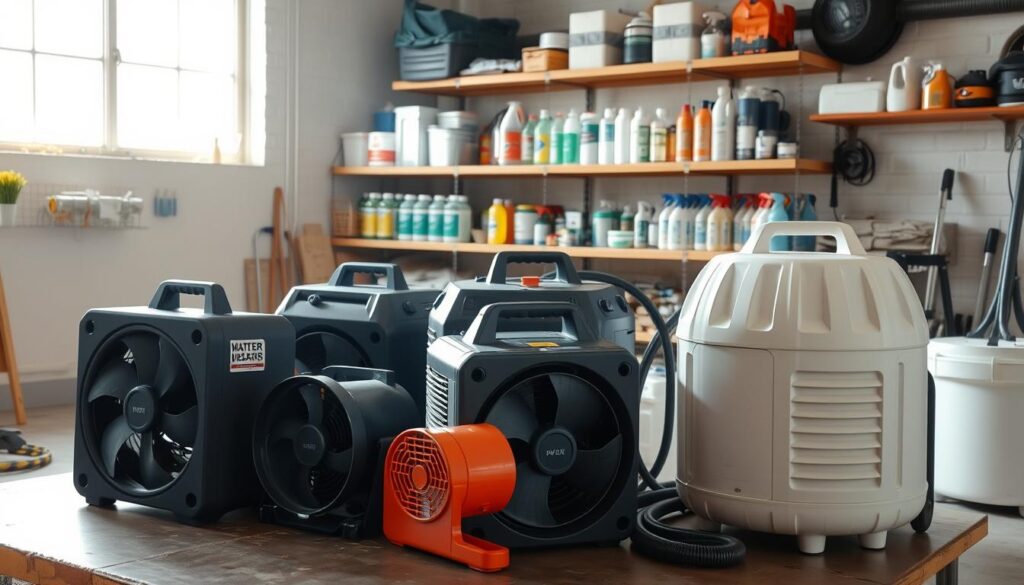
Testing Your Phone After Water Exposure
Testing your phone after water exposure is very important. After trying to dry it, check if it works right. This helps find problems early.
When It’s Safe to Turn Your Phone Back On
Make sure your phone is dry before turning it on. A wet phone can get damaged more. Wait 24 to 48 hours before using it again. This lets moisture dry out, protecting your phone’s inside.
Signs of Lingering Water Damage
Water damage can still show up after drying. Watch for:
- Corrosion on the SIM card or battery contacts
- Water spots or condensation under the screen
- Malfunctioning buttons or switches
If you see these signs, you might need a pro to fix water damaged phone parts.
Functionality Tests to Perform
To check if your phone works right, do these tests:
Testing Speakers and Microphone
Play music or make a call to test the speakers and microphone. If the sound is bad or missing, it might be phone water damage.
Checking Touch Screen Responsiveness
Use your phone’s touch screen to see if it works. If it doesn’t respond well or acts strangely, it might need a pro to fix the water out of phone problem.
By doing these steps, you can check your phone’s condition after water damage. You can then fix it yourself or get help from a pro.
Data Recovery from Water-Damaged Phones
Water damage can lead to data loss on your phone. But, there are ways to get your data back. The damage can be immediate or slow, depending on how bad it is. Quick action and the right methods can help a lot.
Backup Options Before Repairs
It’s key to look at backup options before fixing your phone. If it works, back up your data to iCloud or Google Drive. If it won’t turn on, you might need professional help. Regular backups help avoid losing data.
- Use automatic backup features like iCloud or Google Drive
- Manually back up data to a computer or external hard drive
- Consider using third-party backup apps for additional security
Professional Data Recovery Services
If your phone won’t work after getting wet, professional help is best. These services use special tools to get data back. Companies like Dr. Fone and Disk Drill can help, but success depends on the damage.
Professional services offer many benefits:
- Advanced tools for data extraction
- Expert technicians with experience in handling water-damaged devices
- High success rates for data recovery
Cloud Storage Solutions for Future Protection
Using cloud storage can prevent future data loss. Services like Google Drive, iCloud, and OneDrive offer automatic backups. This keeps your data safe from water damage and other risks.
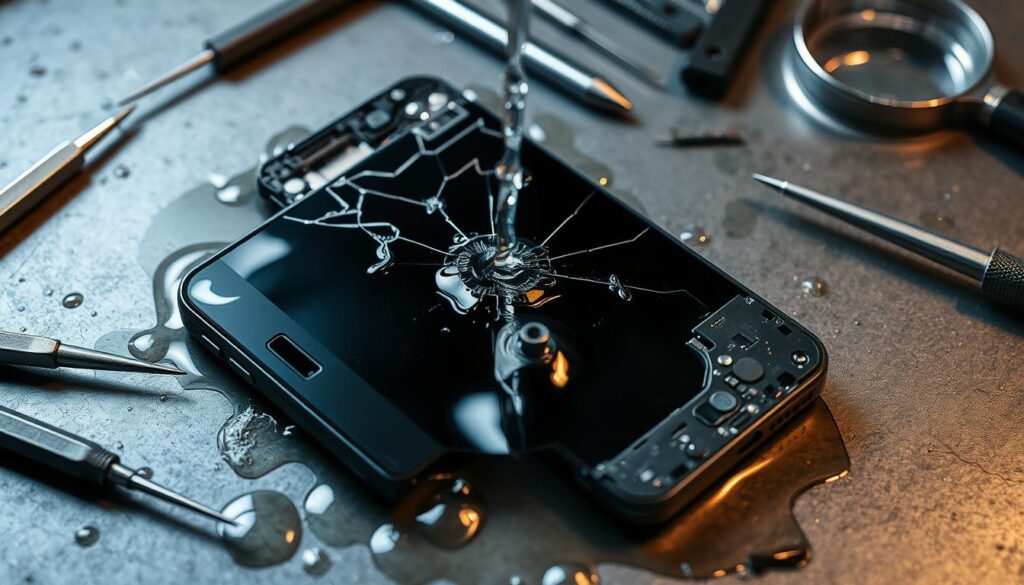
Cloud storage keeps your data safe and easy to reach. Backing up regularly is a smart way to protect your digital life.
Repairing Water-Damaged Components
Fixing water-damaged phone parts needs a careful and detailed approach. Water can cause corrosion and harm to important parts inside your phone. It’s crucial to fix these problems quickly and well.
Cleaning Corroded Contacts
Corrosion on contacts and connectors is common after water damage. Use a soft-bristled brush to gently remove debris. Then, apply a small amount of isopropyl alcohol to a cotton swab to clean the corroded contacts. This helps remove corrosion and improve connection.
For more complex repairs, consider getting help from water damage repair experts.
Addressing Speaker and Microphone Issues
Water damage can harm your phone’s speaker and microphone, causing poor sound quality or failure. Begin by drying the affected areas well. Use a desiccant or silica gel packets to absorb moisture.
If the problem continues, you might need to replace the damaged parts. Sometimes, professional assistance is needed to fix water damaged phone audio parts.
Fixing Water-Damaged Screens
Repairing a water-damaged screen can be tough without professional help. First, check how bad the damage is. If the screen is just wet and not damaged, drying it might fix the problem.
But if the screen is cracked or not working, it might need to be replaced. In such cases, visiting a professional repair service for a water damaged phone fix is wise.
In summary, fixing water-damaged phone parts involves several steps, from cleaning corroded contacts to fixing speakers, microphones, and screens. By following these steps, you might be able to fix your phone. But for severe damage, getting professional help is usually the best option.
When to Seek Professional Help
DIY methods can help your phone after water damage. But, some cases need a pro’s touch. Knowing when to ask for help is key to saving your device and data.
Signs That DIY Methods Aren’t Enough
If DIY efforts don’t work, and your phone shows:
- Corrosion on the internal parts
- Moisture that won’t go away
- Charging ports that don’t work
- Problems with the speaker or microphone
It’s time to call in the experts. Professional repair services have the right tools and know-how to tackle tough problems.
What to Expect from Professional Repair Services
Experts in water damage restoration offer full solutions. They’ll check the damage, clean and fix or replace parts, and make sure your phone works right. For more tips on fixing water damage, check out Asurion’s guide.
Cost Considerations for Professional Repair
The price for professional repair depends on the damage and your phone model. Always ask for a quote first. Some places might give you a free check-up.
Insurance Coverage Options
See if your phone insurance covers water damage. Many plans protect against accidents, including water. Knowing your coverage can help lower repair costs.
Conclusion
Getting water out of your phone needs fast action and the right steps. We’ve looked at many ways to rescue your phone, from quick fixes to long-term solutions. This includes phone water repair and cleaning up water damage.
By taking these steps, you can increase your phone’s chances of survival. You might use silica gel packets, isopropyl alcohol, or professional tools. The most important thing is to act fast and be careful. If your phone still doesn’t work after trying these methods, it’s time to get help from a professional.
Being ready and knowing how to react when your phone gets wet is crucial. It can save your device and remove water for good.
FAQ
How can I tell if my phone has water damage?
Look for corrosion, water spots, or mineral deposits inside your phone’s ports. Also, check if your phone’s Liquid Contact Indicator (LCI) has turned red or pink. This usually means your phone has been exposed to water.
Can I fix water damage on my phone myself?
Yes, you can try to fix water damage yourself. Use drying methods like silica gel packets or the rice method. But, if you’re not sure, it’s best to get professional help.
What is the best method to dry out a wet phone?
The best method is to use silica gel packets or commercial desiccants to absorb moisture. The rice method can also work, but be careful of rice dust getting into your phone’s ports.
Should I use a hair dryer to dry my phone?
No, don’t use a hair dryer. It can push moisture deeper into your phone and damage internal parts because of the heat.
Can I use isopropyl alcohol to clean my water-damaged phone?
Yes, isopropyl alcohol can help displace water and clean corrosion. But, make sure to follow safety precautions and techniques to avoid harming your device.
How long should I wait before turning on my phone after water exposure?
Wait at least 48 to 72 hours before turning on your phone. This ensures it’s dry and reduces the risk of short circuits.
What are the signs of lingering water damage in my phone?
Look out for malfunctioning speakers or microphones, unresponsive touch screens, corrosion, or if your phone won’t turn on. These are signs of water damage.
Can water damage be repaired by a professional?
Yes, professionals can fix water damage. They use tools like ultrasonic cleaners and heat treatment to restore your phone.
How can I recover data from a water-damaged phone?
Try to recover data with professional services or by restoring from a backup. Using cloud storage can also help protect your data in the future.
Is it worth seeking professional help for water damage repair?
Yes, if DIY methods don’t work, professional help is worth it. It can prevent further damage and ensure a proper repair.
What are the costs associated with professional water damage repair?
Costs vary based on damage, phone type, and repair service. Get a quote from the service and check if your insurance covers water damage.
How can I prevent water damage to my phone in the future?
Use a waterproof case and be careful near water. Choose a phone with a high IP rating, like IP67 or IP68, to reduce water damage risk.
